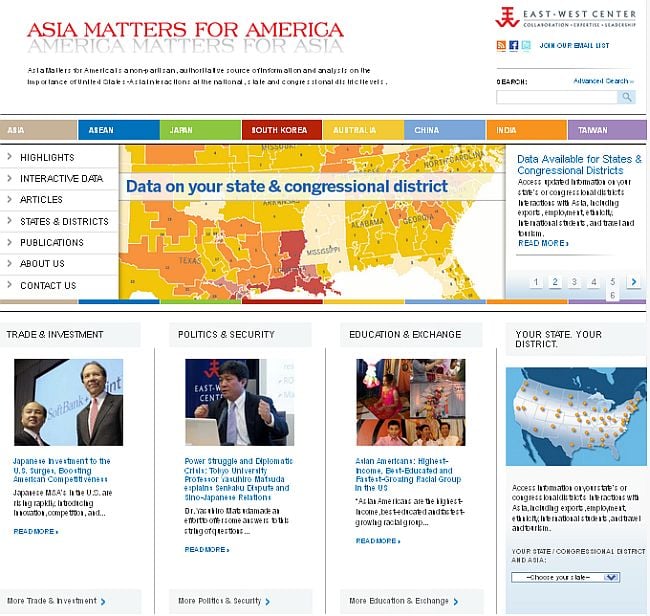
Asia Matters for America / America Matters for Asia is an interactive resource from the East-West Center for credible and nonpartisan information, graphics, analysis and news on US-Asia Pacific relations at the national, state and local levels. Image: AsiaMattersforAmerica.org
Asia really does matter for America, and the East-West Center initiative Asia Matters for America / America Matters for Asia has the empirical data showing it. However, this initiative goes beyond just data, it is designed to be a credible resource for information, graphics, analysis and news on U.S.-Asia Pacific relations at the national, state and local levels. (Full disclosure: I do work at the East-West Center, and I am one of the team members who contribute research and content to this initiative.)
We have just concluded updating two major projects that examine U.S. engagement with Asia at the State and Congressional District level, in addition to a new edition of the “America Matters for America / America Matters for Asia” publication that gives a comprehensive overview of U.S. interactions throughout Asia.
In short, users can now find data for every U.S. state and congressional district and its engagement with Asia across a number of different variables:

Every U.S. state and congressional district is listed, highlighting a defined set of interactions with Asia. Image: AsiaMattersforAmerica.org
The Asia Matters for America/America Matters for Asia booklet moves from the subnational state and congressional district level to wider national engagement.
28 percent of all U.S. goods exports go to Asia as do 27 percent of services exports. Have a look at the booklet and see how this breaks down per state capita, the composition of these exports, along with other interesting facts and figures.
Investment into the United States from Asia continues to grow. Globally, Japan ranks as the second largest source of investment into the United States, and even through the recent global financial crisis investment from Asia into the United States has continued to grow.
64 percent of all foreign students in the United States come from Asia, contributing $14 billion to the U.S. economy in tuition and living expenses, etc.
Likewise, with travel and tourism from Asia, 8.5 million Asian visitors contributed $41 billion to the U.S. economy, with Japanese guests spending the most, almost $15 billion.
U.S. students studying abroad are increasingly looking to Asia, for example, since the 2001/02 academic year U.S. students deciding to study in India have increased by an annual growth rate of almost 25 percent as covered in this post on the AMA website: U.S. Students Studying in India Show Strong Ten-Year Upward Growth
Asia is increasingly in the news, and unfortunately it is not always good news. North Korea, territorial disputes and rising powers continually make headlines. There are also non-traditional security threats including pandemic diseases, environmental degradation and natural disasters that negatively impact the region and beyond.
However, in my opinion, the two projects that we have just released as part of the Asia Matters for America/America Matters for Asia initiative go beyond the headlines to explain exactly why the United States is going to stay engaged with Asia for the long-term.
The United States is already firmly embedded in Asia in terms of economic, culture and social ties. Look at the exports, look at the U.S. population that is Asian-American (Asian Americans: Highest-Income, Best-Educated and Fastest-Growing Racial Group in the U.S.), look at the investment, look at travel and tourism, look at international students, the list goes on.
The foundations are clearly already in place across the spectrum and these two projects – the Asia Matters for America/America Matters for Asia booklet and the state and congressional district one-pagers – are a very concise, user friendly source for this information that one should not keep to oneself!
Damien Tomkins is Project Assistant at the East-West Center office in Washington, D.C. where he contributes research and content to the Asia Matters for America initiative and coordinates the Asia Pacific Bulletin publication series. The views expressed here are solely those of the author and not of any organization with which he is affiliated.